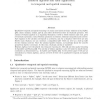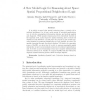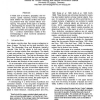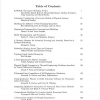IGARSS
2009
14 years 4 months ago
2009
High resolution remote sensing (HR RS) images allow discriminating between different objects in a scene. Spatial reasoning techniques can be used to interpret and describe the sce...
KI
2002
Springer
14 years 6 months ago
2002
Springer
In many approaches for qualitative spatial reasoning, navigation of an agent in a more or less static environment is considered (e.g. in the double-cross calculus [12]). However, i...
EXPERT
2002
14 years 6 months ago
2002
Spatial reasoning is a major source of difficulties for strategy game AIs. We conjecture that qualitative spatial reasoning techniques can help overcome these difficulties. We bri...
AIR
2005
14 years 6 months ago
2005
Qualitative temporal and spatial reasoning is in many cases based on binary relations such as before, after, starts, contains, contact, part of, and others derived from these by r...
IJAR
2006
14 years 6 months ago
2006
In spatial reasoning, in particular for applications in image understanding, structure recognition and computer vision, a lot of attention has to be paid to spatial relationships ...
CONSTRAINTS
2006
14 years 6 months ago
2006
Topological relations are important in various tasks of spatial reasoning, scene description and object recognition. The RCC8 spatial constraint language developed by Randell, Cui...
AMAI
2007
Springer
14 years 7 months ago
2007
Springer
It is widely accepted that spatial reasoning plays a central role in artificial intelligence, for it has a wide variety of potential applications, e.g., in robotics, geographical...
IJCAI
2003
14 years 8 months ago
2003
In fields such as medicine, geography, and mechanics, spatial reasoning involves reasoning about entities—for example cavities and invading particles—that may coincide without...
FLAIRS
2001
14 years 8 months ago
2001
This paper presents arguments for the application of a multiagent approach to spatial reasoning, and it is shown how spatial reasoning benefits from an agent-based implementation....
SBIA
1995
Springer
14 years 10 months ago
1995
Springer
ion Framework for Compositional Modeling 36 Diane Chi and Yumi Iwasaki Model Decomposition and Simulation 45 Daniel J. Clancy and Benjamin Kuipers A Distance Measure for Attention ...




